16 September 2013
Voyager 1, Distance, and The CNN Salute
Posted by Dan Satterfield
Last week’s news that Voyager 1 had become the first human made object to enter interstellar space gave almost everyone a pause, including me. I was a young and dumb freshman student at the University of Oklahoma that fall, trying to get my head around calculus as matter of fact. It’s been thirty-six years, and my hair is gray, but Voyager travels on.
I suspect a lot of teachers around the world are trying to come up with a way to explain just how far away Voyager 1 is, and some may be making the mistake of saying that Voyager 1 has left the solar system. That, it has not done, because there is still the Oort cloud of objects to cross. Fox News made that mistake, and so have several other news outlets.
NBC News did a good job of explaining this, and NASA was very careful in all its press releases to NOT say the words “left the solar system”. The Oort cloud may extend to a distance of 100,000 Astronomical Units(AU), and Voyager is now 125 AU away from the Sun. An AU is just the distance from Earth to the Sun, about 93 million miles. One could argue that the boundary to interstellar space IS the boundary of the Solar System, so I’m not sure that this error is that egregious.
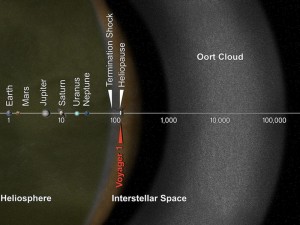 Just how far away from home Voyager One has traveled, isn’t an easy thing to comprehend, and using miles or kilometers doesn’t cut it! Someone at the BBC decided to try and do better, and they did. Voyager One is now at a light distance of 17 hours and 24 minutes. This can make sense, when you realize that it takes light only 1/7th of a second to circle the planet, and 8 minutes and 20 seconds to reach the Earth from the Sun. At light speed the Moon is 1.5 seconds away. Anyone who work in TV intuitive understands this as well. How you ask? Mix Minus!
Just how far away from home Voyager One has traveled, isn’t an easy thing to comprehend, and using miles or kilometers doesn’t cut it! Someone at the BBC decided to try and do better, and they did. Voyager One is now at a light distance of 17 hours and 24 minutes. This can make sense, when you realize that it takes light only 1/7th of a second to circle the planet, and 8 minutes and 20 seconds to reach the Earth from the Sun. At light speed the Moon is 1.5 seconds away. Anyone who work in TV intuitive understands this as well. How you ask? Mix Minus!
Here’s the scoop: anytime you are doing a live report via satellite, you always ask the director to turn on mix-minus. This allows you to NOT hear your own voice on air. If this isn’t done, you’ll hear yourself after your words travel 22,000 miles up to the satellite, and then back down to Earth, and then back up and down to you! A distance of just under 100,000 miles, which takes about a second at light speed. Hearing what you say repeated back in your ear a second later is very disconcerting (Trust me on this!). So disconcerting, that almost everyone who is subjected to it (myself included many times) reaches up, and pulls their earpiece out.
In TV, this called doing the CNN salute!
I used the BBC applet to ask how long it would take me to reach Voyager 1 in the Concord. That aircraft traveled at a top speed of 1350 miles per hour. At that speed you can travel from New York to London in 3 hours. If you flew straight up, you would be in space in less than five minutes. You would pass the orbit of the International Space Station in 11 minutes. In the Concord, you could fly around the Earth at the Equator in just 17 hours. It would take a week to reach the Moon (if your air lasted long enough, and your flight did not return to the airport because some nut wrote an empty threat on the bathroom mirror).
The younger folks on-board would live to see a close up view of Jupiter 39 years later, but how long would it take to reach Voyager??
Yes- 984 years.
Voyager’s nuclear power supply is getting weaker each year, and in about five years scientists will have to start shutting down instruments. The light bulb by your bed uses about as much power as the transmitter on Voyager (22 watts), but voyager’s weak signal can be detected easily with NASA’s deep space network of BIG dishes. The new Very Large Baseline Array (VLBA) of telescopes was able to image the signal with extreme precision (real geek coolness here).
The day is fast approaching however when we will no longer be able to talk with our most distant man-made object. The distance is not the problem, since receiver technology has advanced dramatically since Voyager was launched. The new VLBA array could probably see a signal over a light year away according to NASA’s radio astronomy experts! The problem is that enough power to run the gyros (and thus point the antenna) will last only a few more years. As of now, NASA thinks that last contact will be about ten years from now and perhaps sooner if power to the gyros is shut down.
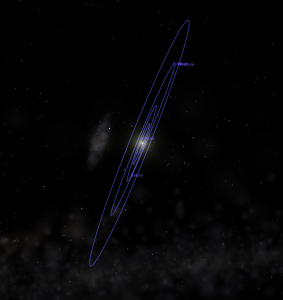 One last cool fact: Voyager will pass less than two light years away from the star Gilese 445 in the year 40,272 ACE. Gilese 445 is actually 17 light years away, but it’s moving toward our sun, and will only be four light years away in 40,000 years! NASA JPL has a great FAQ online that answers a lot of commonly asked questions.
One last cool fact: Voyager will pass less than two light years away from the star Gilese 445 in the year 40,272 ACE. Gilese 445 is actually 17 light years away, but it’s moving toward our sun, and will only be four light years away in 40,000 years! NASA JPL has a great FAQ online that answers a lot of commonly asked questions.
I used the cool program Celestia to see what the sun would look like from where Voyager is right now. From Earth, the Sun is about a half a degree across in the sky. From Voyager, it’s just one of several very bright stars in the sky measuring 0.004 degrees across. The Celestia image on left shows the Sun from 125 AU away, but Voyager is above the plane of the solar system, at about a 35 degree angle.


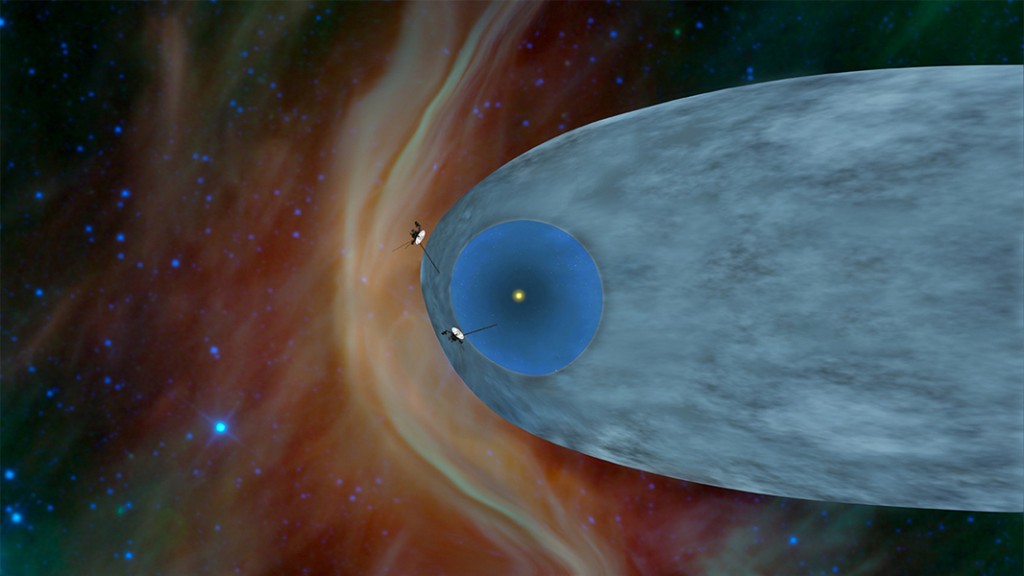
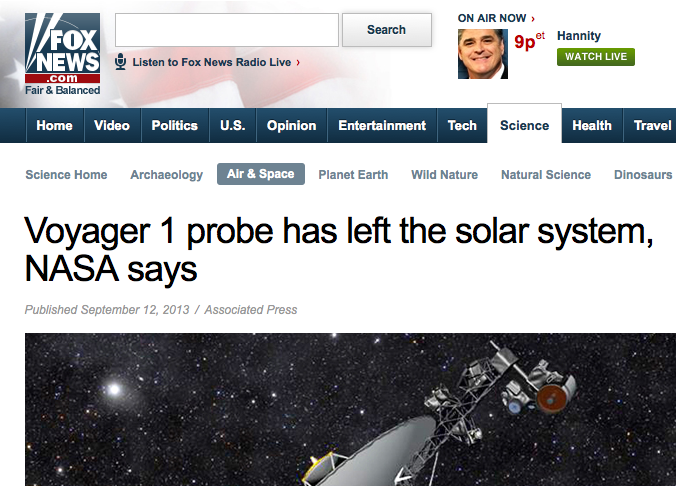
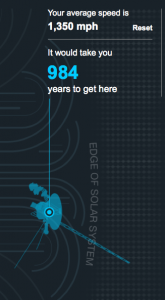
 Dan Satterfield has worked as an on air meteorologist for 32 years in Oklahoma, Florida and Alabama. Forecasting weather is Dan's job, but all of Earth Science is his passion. This journal is where Dan writes about things he has too little time for on air. Dan blogs about peer-reviewed Earth science for Junior High level audiences and up.
Dan Satterfield has worked as an on air meteorologist for 32 years in Oklahoma, Florida and Alabama. Forecasting weather is Dan's job, but all of Earth Science is his passion. This journal is where Dan writes about things he has too little time for on air. Dan blogs about peer-reviewed Earth science for Junior High level audiences and up.
All this hinges on your definition of “solar system”. It’s true that the Voyagers will be in the range of our star’s gravitational influence for a long, long time to come. In fact, you could make the argument that the time involved is practically infinite since the gravitational force from the sun will never be completely zero. Similarly, it is still being influenced by the gravity of the Earth. However, since the only operating instruments on board are fields and particles detectors, the realm of plasma physics comes to the forefront. As far as the fields and particles scientists are concerned, in crossing the heliopause we’ve left the environment of solar system plasma and entered the environment of interstellar plasma.